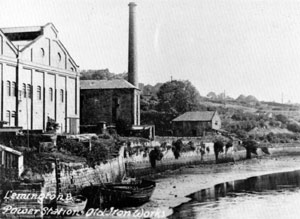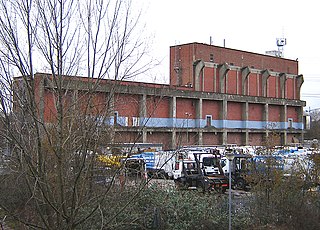
Cockenzie power station was a coal-fired power station in East Lothian, Scotland. It was situated on the south shore of the Firth of Forth, near the town of Cockenzie and Port Seton, 8 mi (13 km) east of the Scottish capital of Edinburgh. The station dominated the local coastline with its distinctive twin chimneys from 1967 until the chimneys' demolition in September 2015. Initially operated by the nationalised South of Scotland Electricity Board, it was operated by Scottish Power following the privatisation of the industry in 1991. In 2005 a WWF report named Cockenzie as the UK's least carbon-efficient power station, in terms of carbon dioxide released per unit of energy generated.

The Agecroft power stations refers to a series of three now demolished coal-fired power stations, which were situated between the eastern bank of the Manchester, Bolton and Bury Canal and the western bank of the River Irwell at Agecroft, Pendlebury, near Manchester, North West England. The stations operated between 1925 and 1993, and were demolished in 1994. HM Prison Forest Bank has since been built on the site.

Littlebrook Power Station was a series of four oil and coal-fired power stations situated on the south bank of the River Thames, next to the Queen Elizabeth 2 Bridge and the Dartford Tunnel in Dartford, Kent. The final power station, Littlebrook D, ceased operating in March 2015, and has now been demolished.

Brimsdown Power Station was a coal-fired power station on the Lee Navigation at Brimsdown in Enfield, North London. The station had seven cooling towers which were visible from a wide area.

Three distinct coal-fired power stations were built at Deptford on the south bank of the River Thames, the first of which is regarded as the first central high-voltage power station in the world.

Dunston Power Station refers to a pair of adjacent coal-fired power stations in the North East of England, now demolished. They were built on the south bank of the River Tyne, in the western outskirts of Dunston in Gateshead. The two stations were built on a site which is now occupied by the MetroCentre. The first power station built on the site was known as Dunston A Power Station, and the second, which gradually replaced it between 1933 and 1950, was known as Dunston B Power Station. The A Station was, in its time, one of the largest in the country, and as well as burning coal had early open cycle gas turbine units. The B Station was the first of a new power station design, and stood as a landmark in the Tyne for over 50 years. From the A Station's opening in 1910 until the B Station's demolition in 1986, they collectively operated from the early days of electricity generation in the United Kingdom, through the industry's nationalisation, and until a decade before its privatisation.

Lemington Power Station was a small, now demolished coal-fired power station, located in North East England. It was situated on the Lemington Gut, a backwater of the River Tyne, at Lemington, 3.5 mi (5.6 km) west of Newcastle upon Tyne. The station's main building stood until 2017 as a rare example of an early power station, dating from before the nationalisation of the United Kingdom's electrical supply industry.

The Stella power stations were a pair of now-demolished coal-fired power stations in the North East of England that were a landmark in the Tyne valley for over 40 years. The stations stood on either side of a bend of the River Tyne: Stella South power station, the larger, near Blaydon in Gateshead, and Stella North power station near Lemington in Newcastle. Their name originated from the nearby Stella Hall, a manor house close to Stella South that by the time of their construction had been demolished and replaced by a housing estate. They operated from shortly after the nationalisation of the British electrical supply industry until two years after the Electricity Act of 1989, when the industry passed into the private sector.

Carville Power Station refers to a pair of now partially demolished coal-fired power stations, situated in North East England on the north bank of the River Tyne at Wallsend. The two stations were built alongside each other on a riverside site about 5 mi (8.0 km) downstream of Newcastle upon Tyne. Carville A Power Station, the first station on the site was opened in 1904, and Carville B Power Station was opened in 1916 to its south.

Forth Banks Power Station refers to a now-demolished coal-fired power station in North East England. It was situated in the city centre of Newcastle upon Tyne on Forth Banks, a street to the rear of Newcastle Central station. Put up in a disused factory building in 1890 by the Newcastle and District Electric Lighting Company (DisCo), it is notable as the first power station in the world to use turbo alternators, as well as being one of the first municipal power stations in the United Kingdom.
Neptune Bank Power Station was a coal-fired power station situated on the River Tyne at Wallsend near Newcastle upon Tyne. Commissioned in 1901 by the Newcastle upon Tyne Electric Supply Company, the station was the first in the world to provide electricity for purposes other than domestic and street lighting. It was also the first in the world to generate electricity using three-phase electrical power distribution at a voltage of 5,500 volts.
The Newcastle and District Electric Lighting Company was a pre-nationalisation, private electricity supply company, based in Newcastle upon Tyne in North East England. The company was set up in 1889 by Charles Algernon Parsons. The company built a number of small coal-fired power stations in the west end of Newcastle upon Tyne, initially to supply homes and streets with electric lighting. They also provided power for an electrified tram line in the western part of the city.

North Tees Power Station refers to a series of three coal-fired power stations on the River Tees at Billingham in County Durham. Overall, they operated from 1921 until 1983, and the C station, the last on the site, was demolished in 1987. Billingham Biomass Power Station is to be built on their site.

Ottovale coke works was a large industrial complex situated at Blaydon Burn, near Blaydon-on-Tyne, Gateshead, North East England. The complex comprised a coke works, tar works and a power station. Built on the site of Dockendale Hall in 1904, it was operated by the Priestman Collieries until the 1970s.

Manors Power Station or the Tramways Generating Station is a former coal-fired power station located in the Manors district of the city centre of Newcastle upon Tyne, Tyne and Wear in North East England. The station's turbine hall and other remaining buildings are Grade II listed.

Pandon Dene Power Station was an early coal-fired power station situated on the Pandon Dene, to the east of Newcastle upon Tyne.

Hackney Power Station was a coal-fired power station situated at Lea Bridge on the River Lee Navigation in London.
Hayle Power Station was a coal-fired power station situated at the mouth of the River Hayle, at Hayle in Cornwall, South West England.
The Ultimo Power Station, or Ultimo Powerhouse, was an electricity generating plant located in the inner-city Sydney suburb of Ultimo, New South Wales. Commissioned in 1899, it was the first major power station in Sydney and was originally built to supply power for the electric tram network. Prior to this, a small installation had existed at Regent Street, which was brought into use on 15 June 1882. Additionally, experimental electric tram operations powered by small generators had been in intermittent use in Sydney since 1890.
Ribble Power Station was a coal-fired electricity generating station on the River Ribble in Penwortham near Preston, Lancashire. The station was built by the Corporation of Preston to replace a small privately-run generating station in the town. It supplied electricity to Preston and the surrounding area from 1923 until 1976. The station was expanded with new equipment in 1943–47 which remained in operation until the power station was closed in 1976 and was subsequently demolished.
















